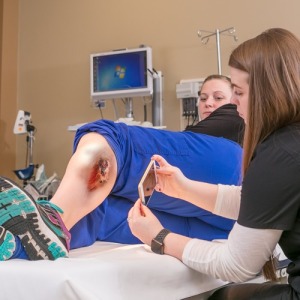by
John R. Fischer, Senior Reporter | March 12, 2018
Try as he might, he could not find the fractured tibia. Scrolling endlessly through the tablet used to photograph the wound, Brian, an audience member taking part in a Novarad demonstration at HIMSS 2018, realized his chances of winning $1000 if he found the photo were all but nonexistent.
The reason: the photo was not there, a feature of Novarad's new mobile app, SnapView, designed to prevent the release of personal health information and on full display at the Las Vegas trade show.
“Imagine someone going through a hyperbaric chamber. They’re going through a whole series of tests and treatments. You want to track progress. You take pictures. Is that a HIPAA violation? Is it on a phone or a personal camera,” Dan Bruck, director of marketing for Novarad, told HCB News. “Capturing photos and other visible light images in the Emergency Department, dermatology, and wound care is necessary but can lead to privacy and workflow issues. With our new SnapView App, you take a picture on any iOS device and it automatically gets routed to our universal archive within the Ncompass package so there are no HIPAA violations.”
Smartphones and other devices lack a standard way of tracking and safeguarding patient data, particularly regarding the integration of non-DICOM images into health care image management workflows, enhancing the risk of images and videos becoming lost outside EHRs and enterprise imaging systems.
SnapView scans a patient’s ID wristband and then the patient, routing image files past the device’s memory and into the Ncompass Universal Archive. This prevents images from being stored in the device’s photo log where they are vulnerable.
A doctor away from the office receives a
notification via AlertView.
Novarad also showcased its AlertView App, designed to alert referring physicians, radiologists or cardiologists when reports are ready for review.
Reviews can take place anywhere through the app by clicking on the text message, enhancing communication and minimizing unnecessary delays and disruptions.
Other features it offers include a patient list for quick searches; extensive filtering capabilities such as modality and time filters; deep linking for enhanced data security; basic report and in-depth full report views; and a display of all key images in a study.
AlertView requires users to punch in their mobile password or scan their fingerprint on their devices before answering a quick security question that appears prior to opening up their first study.
Once answered correctly, the service recognizes the safety of the device, enabling physicians to access studies by merely tapping on the text message.
“Imagine you’re a radiologist and you see a report and you think, 'That patient has a life-threatening STAT condition.' What do you do? You pick up the phone. You try and reach the referring physician,” said Bruck. “Trying to reach one on the first try is not easy. The radiologist is put on hold because the doctor can't be found or is with a patient. This is not efficient. With AlertView, you click, and a text message is immediately sent to the doctor’s phone.”
Both apps are designed with HL7 standardization, are intercompatible with EHRs, and will eventually be available on Android devices.
AlertView is on sale now. SnapView is due for release in the near future.
